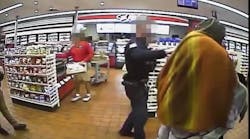Aug. 20--Officer Emily Randles said she always knew there was just one profession out there for her.
"My father worked in a plant and did the same thing every day," said Randles, a police officer and six-year veteran of the Anniston Police Department. "I didn't want a job where I'd do the same thing day-in and day-out."
Randles joined the department as a patrol officer in 2006, but her dreams of being a law enforcement officer might be a rare one for women in Calhoun County. In 2007, almost a quarter of sworn law enforcement officers in the nation were female, up marginally from the 1997 numbers according to the Bureau of Justice.
In Calhoun County, however, those numbers are much smaller. In Oxford, three of the 48 officers on the force are female. Jacksonville and Piedmont each employ just one woman, and Randles is one of two female officers at APD, which employs 93 sworn officers.
The Bureau of Justice numbers indicate that larger police departments, defined as having more than 100 sworn officers on the force, tend to have larger percentages of women as well -- about 14 percent nationally. Some of the largest forces in the country also have the biggest female presence, with Detroit, Philadelphia and Washington D.C. all topping 25 percent of their work force as female. Nationally, smaller departments -- all of Calhoun County's law enforcement agencies qualify as smaller -- have around 8 percent of their force female.
The reasons for the differences in numbers between men and women vary depending on whom you ask. Oxford police Lt. L.G. Owens said Calhoun County's small numbers might represent nothing more than long-held regional beliefs.
"In the South especially, it's not really a field that's attracted a lot of women," Owens said.
That stereotype, said Randles and Officer Brandi McCoy, Anniston's other female officer, is pretty prevalent.
"For so long it's been a male-dominant field," Randles said. "Maybe they've stuck with more traditional roles likes teachers."
"It's not a job for just anybody," McCoy added.
According to Anniston police Lt. Allen George, the job not being for just anybody has presented longtime recruitment challenge for both men and women. George said numbers of those wanting to wear the badge for a living have dropped considerably over the years. He said that when he went through the law enforcement academy, more than 250 people took the entry test along with him. This year, there were fewer than 50.
But even within those numbers, George said the percentage of women has remained small.
"We do everything we can to try and recruit women," George said. "We encourage them to apply."
Calhoun County Sheriff's Office Chief Deputy Matthew Wade said the small percentage of women officers might be due to outdated views of gender roles that dictate what jobs are appropriate for women and men.
"Traditionally, long ago, it was primarily a man's job," Wade said. "But women have just as much an opportunity as a man to work in law enforcement if that's what they want to do."
But if it's not what they want to do, then it becomes harder to recruit women, Wade said.
"Right now we have four openings and six applicants," Wade said. "Only one of them is a woman. We really can't do much about that."
But the biggest detriment of all, George said, might be the physical component of the job, which he said drives away even some of the small number of women interested in law enforcement.
Randles and McCoy said they hear that one a lot, too.
"'You're so small,'" McCoy said is the response she often gets when she tells people what she does for a living. For Randles, it's "'I don't know how you do that, aren't you scared?'"
But both women said those responses are coming from people who don't understand how police officers look after each other.
"They treat us kind of like little sisters," said Randles, explaining how male officers seemed to take extra care to look after the women on the force. She added that she saw nothing sexist or condescending about that attitude.
"For the most part, they're just being the Southern gentlemen they were always taught to be," Randles said.
Furthermore, she said, having fewer women on the force makes the job harder for the men -- not the women.
"There are a lot of things that we can do better," Randles said, explaining that men often find it difficult to frisk women. "I think they wish there was more of us."
But the day-to-day reality of the job, Randles said, leaves little time for worrying about the differences between men and women. Carrying one's self with confidence, being professional and staying safe reach across gender lines for all police officers.
"It's just about being smart," Randles said. "That's the same for all of us."
Star staff writer Brian Anderson: 256-235-3546. On Twitter @BAnderson_Star.
Copyright 2012 - The Anniston Star, Ala.


